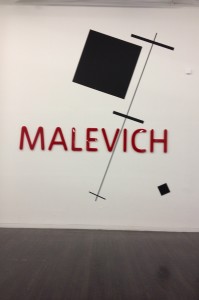Malevich – Tate Modern, London

Malevich’s ‘Black Square’ was first exhibited in 1915, in an exhibition entitled 0.10 in St Petersburg. There has been some debate, but if we take the artist’s word for it, it marks the first time in art history that a painting was not attempting to depict anything. It is not figurative, it is not an impression, it is simply a black square, a novel idea which places the moment of creation at the forefront, rather than the artist’s skill in representing a moment, a personality, a moral. Malevich named the movement Suprematism. Furthermore, in 0.10, which brought together Suprematist works for the public’s consumption for the first time, Black Square was placed in the position normally reserved for a religious icon in a Russian home, positioned in a corner to look over the room. This single work had a profound influence on art history, and became something of a legend, particularly as Suprematism fell out of favour with the introduction of socialist realism, and Black Square was not exhibited for decades, until after the perestroika of the 1980s.
The question for the exhibition team, then, must have been how to recreate this impact in an age where access to high quality reproductions is easy, and where seminal works can lose something of their impact through becoming ubiquitous. The chronological hang was the first step to overcoming these risks. Malevich seems to have consumed modern ideas about art through trying them out, and the room displaying his early work flits from style to style, the paintings displaying some talent, but little originality. Momentum starts to build, however, as his works becomes more deliberately Russian, more avant-garde, as he began to reject conventions and even language and reason (do remind me never to see the opera Victory Over the Sun, it seems interesting in theory but unbearable in practice…). The work itself is then presented to the viewer, or, at least one version of it. Multiple Black Squares were painted by Malevich, who adopted it as his symbol throughout his life, and unfortunately the first is too fragile to travel. Another version is in the next room, in which the curators have painstakingly put back together the original 0.10 exhibition, with as many of the works whose whereabouts are known, and using a single photograph of the original show as a guide. This is the cathartic moment after the building anticipation. The sense of being able to be close to what Malevich originally intended with the works is powerful, and I think helps to overcome any cynicism. Having seen where modern art came from in the work of one artist, the importance of Suprematism as a liberation of painting is apparent, and the viewer can participate in the shock of the new as did the audiences of a century ago.
The second notion from this exhibition which I found interesting is most apparent in the room which presents Malevich’s works on paper, almost an exhibition within an exhibition, and which describes some of the personal collections which make up the exhibition loans. Nikolai Khardziev was personally connected to the world of Russian avant-garde art and literature, and built an archive of works and materials, some of which went to the Netherlands in somewhat scandalous circumstances in the 1990s. George Costakis was born in Russia to Greek parents, and began to collect Suprematist and Constructivist works in the 1940s after discovering them by chance. His collection is now in the State Museum of Contemporary Art in Greece. The fact that both men collected works that could at the very least have led to the suspicion of the authorities, is perhaps testament to the importance of art to the individual. The fact that large collections of important works by Malevich now reside in Thessaloniki and Amsterdam, is indicative of the turbulent history of Russia and Russian art in the 20th century: the imposition of ‘official’ styles, the fear of non-conformists, and also the unstable economic situation which reduced the base of artists and art collectors. While there are other important works by Malevich held in the collections of museums in Russia and elsewhere, would an exhibition of this scope have been possible had individual collectors not taken upon themselves the preservation of a then outmoded and slightly dangerous artistic movement? One wonders if this can happen anywhere today, given globalisation and the reach of the art market. Ai Weiwei may have political troubles at home, for example, but there is no risk that his work will sit dusty and forgotten on a shelf in China. Works of art are destroyed in various contexts with alarming regularity, but this I think is a separate issue than simply trying to forget an artist. Or is it?
In any event, this was an exhibition that gave me a few ideas to come away and think about which is always a welcome result. I was slightly overwhelmed by the number of works, but this is a regular feature of ‘blockbuster’ shows. I was also slightly saddened by the return to conventional styles in Malevich’s later works. Suprematism always would have had a shelf life as a movement, given its rejection of pretty much everything, but the fact that Malevich continued to use a black square as a signature is slightly poignant, hinting at artistic expression stifled by politics. I hope he would be gratified to see the elevated position in the artistic canon which Black Square retains a century after its creation.
